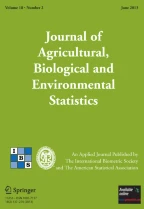Abstract
The search for species associations is one of the classical problems of community ecology. This article proposes to use Kendall’s coefficient of concordance (W) to identify groups of significantly associated species in field survey data. An overall test of independence of all species is first carried out. If the null hypothesis is rejected, one looks for groups of correlated species and, within each group, tests the contribution of each species to the overall statistic, using a permutation test. A field survey of oribatid mites in the peat blanket surrounding a bog lake is presented as an example. In the permutation framework, an a posteriori test of the contribution of each “judge” (species) to the overall W concordance statistic is possible; this is not the case in the classical testing framework. A simulation study showed that when the number of judges is small, which is the case in most real-life applications of Kendall’s test of concordance, the classical χ2 test is overly conservative, whereas the permutation test has correct Type 1 error; power of the permutation test is thus also higher. The interpretation and usefulness of the a posteriori tests are discussed in the framework of environmental studies. They can help identify groups of concordant species that can be used as indices of the quality of the environment, in particular in cases of pollution or contamination of the environment.
Similar content being viewed by others
References
Baird, D. (1988), “Significance Tests, History and Logic,” in Encyclopedia of Statistical Sciences (vol. 8), eds. S. Kotz and N. L. Johnson, New York: Wiley, pp. 466–471.
Borcard, D., and Legendre, P. (1994), “Environmental Control and Spatial Structure in Ecological Communities: An Example Using Oribatid Mites (Acari, Oribatei),” Environmental and Ecological Statistics, 1, 37–53.
Borcard, D., Legendre, P., and Drapeau, P. (1992), “Partialling Out the Spatial Component of Ecological Variation,” Ecology, 73, 1045–1055.
Borcard, D., Legendre, P., Avois-Jacquet, C., and Tuomisto, H. (2004), “Dissecting the Spatial Structure of Ecological Data at Multiple Scales,” Ecology, 85, 1826–1832.
Calinski, T., and Harabasz, J. (1974), “A Dendrite Method for Cluster Analysis,” Communications in Statistics, 3, 1–27.
Edgington, E. S. (1995), Randomization Tests (3rd ed.), New York: Marcel Dekker.
Fager, E. W., and McGowan, J. A. (1963), “Zooplankton Species Groups in the North Pacific,” Science (Washington DC), 140, 453–460.
Gleason, H. A. (1926), “The Individualistic Concept of the Plant Association,” Bulletin of the Torrey Botanical Club, 53, 7–26.
Holm, S. (1979), “A Simple Sequentially Rejective Multiple Test Procedure,” Scandinavian Journal of Statistics, 6, 65–70.
Hope, A. C. A. (1968), “A Simplified Monte Carlo Test Procedure,” Journal of the Royal Statistical Society, Ser. B, 50, 35–45.
Jackson, D. A., Somers, K. M., and Harvey, H. A. (1992), “Null Models and Fish Communities: Evidence of Nonrandom Patterns,” The American Naturalist, 139, 930–951.
Legendre, P. (2000), “Comparison of Permutation Methods for the Partial Correlation and Partial Mantel Tests,” Journal of Statistical Computation and Simulation, 67, 37–73.
Legendre, P., and Gallagher, E. D. (2001), “Ecologically Meaningful Transformations for Ordination of Species Data,” Oecologia, 129, 271–280.
Legendre, P., and Legendre, L. (1998), Numerical Ecology (2nd English ed.), Amsterdam: Elsevier Science BV.
Milligan, G. W., and Cooper, M. C. (1985), “An Examination of Procedures for Determining the Number of Clusters in a Dataset,” Psychometrika, 50, 159–179.
Pavillard, J. (1912), “Essai sur la Nomenclature Phytogéographique,” Bulletin de la Société Languedocienne de Géographie, 35, 165–176.
Rao, C. R. (1995), “A Review of Canonical Coordinates and an Alternative to Correspondence Analysis Using Hellinger Distance,” Qüestiió (Quaderns d’Estadística i Investigació Operativa), 19, 23–63.
Siegel, S. (1956), Nonparametric Statistics for the Behavioral Sciences, New York: McGraw-Hill.
Siegel, S., and Castellan, N. J., Jr. (1988), Nonparametric Statistics for the Behavioral Sciences (2nd ed.), New York: McGraw-Hill.
Whittaker, R. H. (1956), “Vegetation of the Great Smoky Mountains,“ Ecological Monographs, 26, 1–80.
— (1962), “Classification of Natural Communities,” The Botanical Review, 28, 1–239.
Wright, S. P. (1992), “Adjusted P Values for Simultaneous Inference,” Biometrics, 48, 1005–1013.
Zar, J. H. (1999), Biostatistical Analysis (4th ed.), Upper Saddle River, New Jersey: Prentice Hall.
Author information
Authors and Affiliations
Corresponding author
Rights and permissions
About this article
Cite this article
Legendre, P. Species associations: the Kendall coefficient of concordance revisited. JABES 10, 226–245 (2005). https://doi.org/10.1198/108571105X46642
Received:
Revised:
Issue Date:
DOI: https://doi.org/10.1198/108571105X46642
